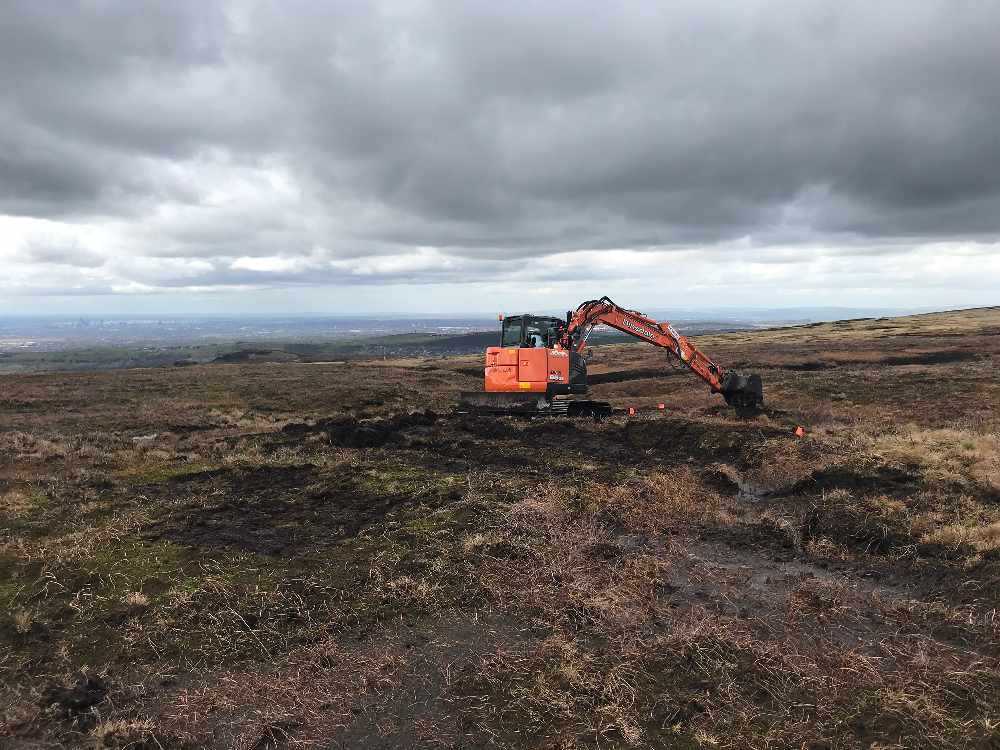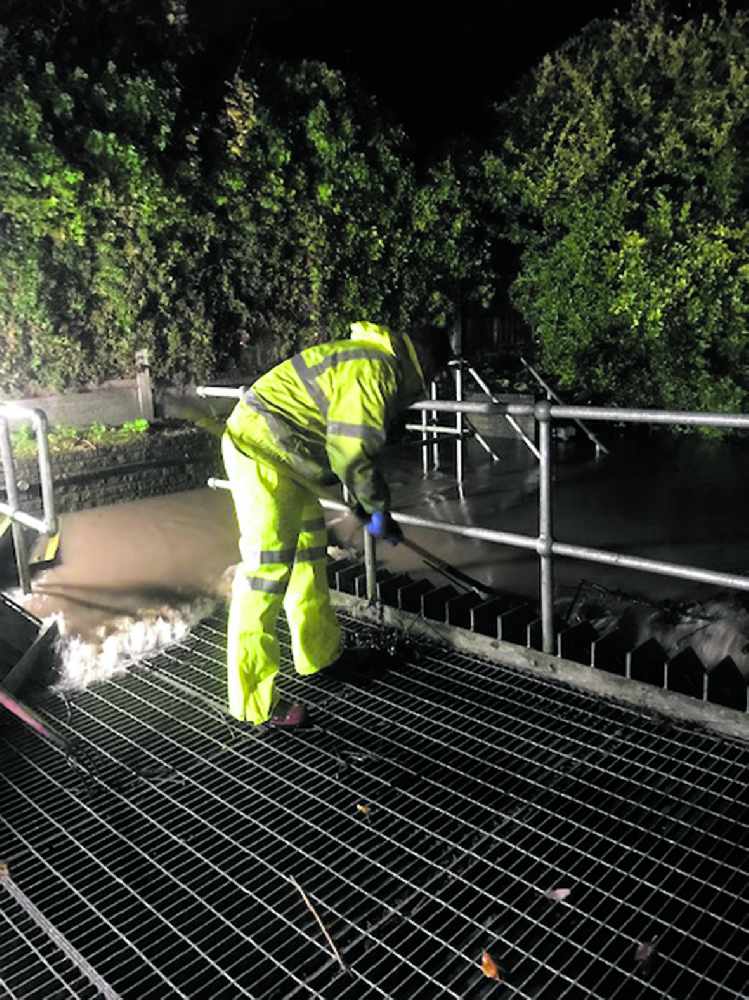
Spring is in the air but, for Environment Agency Area Director Lesley Worswick, it's been one of the most eventful starts to the new year as the weather throws everything our way.
This month, she explains how the agency is preparing to meet the challenge of climate change - including here locally across the moors above Stalybridge.
Well the evenings are getting lighter, and browsing through our local Twitter feed @EnvAgencyNW this week, I spotted a post showcasing frog spawn on one of our leaky dam sites!
I don’t know about you, but for me seeing frog spawn is a sure sign that spring really is on the way.
The weather, it has to be said, has turned on a sixpence. It doesn’t seem more than a month ago that Storm Christoph hit, leaving a trail of devastation across the North West.
Over that short but memorable period of January 18-21 this year, levels of water in the River Mersey broke records.
In Didsbury at the vast flood storage reservoir, which is capable of holding up to 310 Olympic size swimming pools of water, the distance between safety and a threat to people’s lives was a matter of centimetres.
But, the defences there held firm and protected around 3,000 properties.

DIDSBURY BASIN: Vast flood storage reservoir.
It was one of the wettest three days on record. Throughout the incident, our teams and our partners, in the police and fire services, local authorities and utility companies, to name but a few, took a ‘think big, act early approach’ meaning we were able to protect more than 24,000 properties and businesses through a combination of operating defences and assets.
We were also able to warn more than 6,000 people in advance of Christoph’s arrival through our flood warning service.
In real terms, that means that tens of thousands of people were not displaced from their homes.
But sadly despite our actions, nature found a way through, and at least 369 properties across Greater Manchester and Cheshire fell victim to the misery of flooding.
Every flooded property is a personal tragedy.
To the people that did suffer flooding, they are not just bricks and mortar on a map, they are their homes or businesses.
The experience of having your property flooded is hugely distressing. The emotional and economic damage leaves a lasting impact that cannot be scrubbed away with the mud.

PALATINE ROAD: Flood defences in the storm.
This last month, I’ve been speaking with MPs representing the communities coping with the worst of the impacts and their constituents’ grief is profound.
That being said, the local response has been characteristic of the great community spirit we see in England following flood incidents and I have heard several heart-warming stories of neighbours helping each other out despite anxiety about coronavirus.
From our side, we will always do everything we can to protect communities at risk, but it will take time to recover from the impacts of Storm Christoph.
The experience of Christoph highlights the importance of investing in creating and maintaining flood defences.
In excess of £115m has been invested in flood defences across Greater Manchester, Merseyside and Cheshire since 2010, providing better protection for around 6,150 homes.
For every £1 spent improving protection from flooding and coastal erosion, we avoid around £5 of property damages. Money for flood protection is also an investment in economic restoration, and a way of improving health and well-being by enhancing our green spaces.
Over the next six years, you can be certain that there will be even more investment in flood risk management across Greater Manchester.
But, with climate change bringing ever more intense and frequent storms, we have to start thinking outside the box of traditional flood protection.
Last month, the community of Stalybridge was the focus of a significant new plan to reduce flooding.
Along, the western fringe of the Pennines, we have identified 22 communities at risk of flooding as part of the as part of ‘ProtectNFM’ project.

UNDERWAY: ProtectNFM project.
Funded by the Environment Agency and delivered in partnership with The University of Manchester and Moors for the Future, the aim of the project in Stalybridge was to help restore those superheroes of our ecosystem, moorland and mosses, to capture carbon and slow the flow of flood water through the construction of ‘leaky barriers.’
Leaky barriers are made of natural materials, laid in streams and ditches.
They are designed to reduce downstream flood peak by temporarily slowing or holding water.
In Stalybridge, ten innovative, large stone dams have been built along the moorland by placing boulders from a local quarry at selected ‘pinch-points’ along the watercourse.
These, along with 143 peat dams, 29 small stone dams and 20 timber dams can hold back litres of storm water and help to prevent flooding.
In fact, these clever natural barriers have already proved their worth by holding back the rainwater seen in recent weeks.

DEBRIS SCREEN: Cleaning up after the storm.
Our work in Stalybridge is a fantastic example of how we are meeting the ambitions set out in our Flood and Coastal Erosion Risk Management Strategy and delivering the government’s 25 year environment plan, while also tackling climate change and creating a better place for our communities.
It shows the real potential these natural interventions can have, we just need to do more of them, lots more!
Evidence from Stalybridge is now being gathered to fully understand the benefits of natural flood management and identify other locations that may benefit from these schemes.
This just goes to show that the impacts of climate change are already being tackled and led by local communities.
This year, the UK hosts the international (COP26) climate summit in Glasgow.
This is a key moment to address our impact on the environment through carbon emissions, and better prepare the world for climate shocks like Storm Christoph.
We know local experience can inform global responses and that ambitions for change can be delivered by communities such as those across Greater Manchester.
You can be reassured that we will be there right alongside them delivering local resilience to the climate emergency.

Environment Agency Area Director Lesley Worswick
Main image:
PILOT PROJECT: Stalybridge dam works.


 ELECTION: The results as they come in...
ELECTION: The results as they come in...
 ELECTION: The turnout for each ward being contested in Tameside
ELECTION: The turnout for each ward being contested in Tameside
 ELECTION: 'Palestine could make the result tighter than we would like' - Labour
ELECTION: 'Palestine could make the result tighter than we would like' - Labour
 ELECTION: Independent says councillors did not do enough for Stalybridge after tornado
ELECTION: Independent says councillors did not do enough for Stalybridge after tornado


